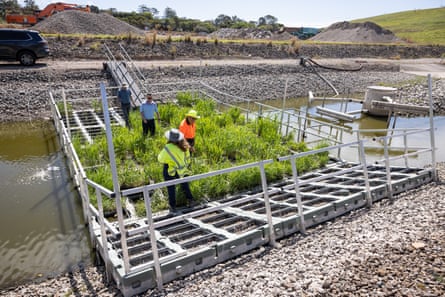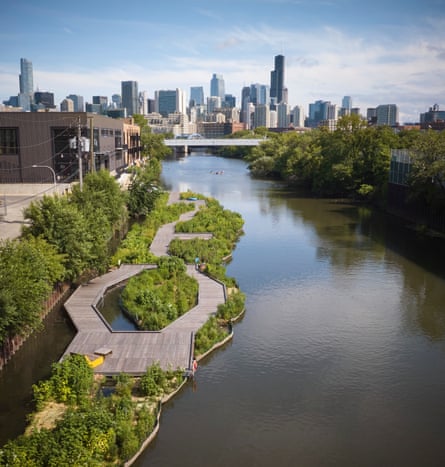As the plants are pulled out of one of the cells of their floating pod, the long and thin roots are covered with slime.
“This is what you want,” says Chris Walker, an environmental engineer who is struggling to keep hold of the weight of the clump of reeds.
“It’s biofilm and it’s taking up all those nutrients and breaking them up.”
A steady stream of utility vehicles and trailers comes in and out of the Sunshine Coast council’s resource recovery centre in Caloundra, dropping off piles of garden clippings and soil that are pushed by a dumper truck into a tiny mountain which, given time, will turn into compost.
Sign up: AU Breaking News email
Walker is in Queensland with Prof Simon Beecham from the University of Adelaide to inspect an artificial floating wetland that’s been deployed in a pond to help soak up the floods of nitrogen and phosphorus that run from all those garden clippings after rain falls.

“We’re dealing with heavy pollutants and they come with significant maintenance needs,” says Walker, who works for engineering consultants Covey. “We don’t want it going in there,” he adds, pointing to bushland just over the bank of the pond.
The council, with Walker’s help, has deployed a small artificial floating wetland to the pond – a buoyant jigsaw of heavy-duty plastic pods with fast-growing reeds planted in the holes. The plants are doing the work of extra chemicals and other engineering to grab and lock up the nutrients in water, stopping it from going putrid.
It’s just one example of an artificial floating wetland that are being increasingly used around the world in rivers, lagoons and wastewater treatment ponds to clean up water – and in some cases, bring new habitats for wildlife.

In Florida, an almost 4,000 sq metre floating wetland is being used to help take pesticides and nutrients out of a recreation area and stop them entering a lagoon.
In the middle of Chicago, an industrial stretch of the city’s Chicago river is being transformed with floating wetlands with boardwalks attached; elsewhere on the river floating plant beds are cleaning up a creek and providing habitat for birds and aquatic mammals.
In Pakistan, floating wetlands have been deployed to clean up a crude oil wastewater pit; while in Canada, they’re being used to treat domestic wastewater.
“We have always been taught that solutions need hard engineering – you had a system and you add a process and some chemicals,” says Beecham.
“But we’ve worked out that no matter how hard you engineer something, nature filters everything much better than anything else. Engineers are working out that nature does a pretty good job by itself. If you can use nature, you’ll come out with a more optimal answer.”
Beecham and Walker are co-authors of new research documenting the economics of floating wetlands around the world, finding they were a cost-effective way to improve water quality.
after newsletter promotion
The wetlands vary in style and application: some combine natural materials to make the floating platforms that will need replacing every few years; others can last 20 years or more.
“What’s been missing is the economics of it,” says Walker.
Dr John Awad, the study’s lead author from the CSIRO, says they found floating wetlands were competitive – cost wise – with other engineering options.
“Floating wetlands mimic the functions of natural ecosystems, filtering nutrients and pollutants through plant roots and microbial communities.
“But until now, there’s been limited data on what they actually cost to build, maintain and operate at scale.”
The study looked closely at 11 floating wetlands around the world, finding generally that the larger they got, the cheaper the cost per kilogram to remove nutrients.
“Scale matters,” he says. “Climate also plays a role. Wetlands in warmer regions had longer growing seasons and higher pollutant removal rates.”
He says the study also showed floating wetlands could be a “particularly valuable option in low- and middle-income countries, where affordable, low-energy treatment systems are urgently needed”.

 4 hours ago
7
4 hours ago
7

















































